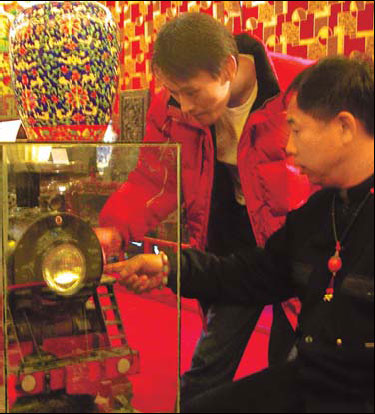


Last week, I visited the Story of Movie Museum, China's first private museum devoted to the history of films. Founded early this year by talk show host and celebrity Cui Yongyuan, the 650-square-meter museum houses hundreds of copies of the Story of Movie, a documentary project Cui himself initiated in early 2003 to record the stories of early Chinese films.
On April 19, Cui signed an agreement with Anren town in Dayi county, southwestern Sichuan province, to establish the first branch of the private museum.

Although his museum may expand to more cities in the coming years, Cui admits he is still unsure if he can keep the museum running smoothly.
The establishment of the Beijing museum has already cost more than 1.5 million yuan ($220,000), which Cui managed with support from his business friends. And the developer of that residential area has signed an agreement, allowing Cui to use the two-story building, which houses the museum, for free permanently.
Even so, running the museum poses a challenge for Cui who reveals that the monthly operational costs are about 40,000 yuan.
Cui is among the very few private museum owners who have the kind of support he has, thanks to their charisma and extensive social network.
But for most private museum owners, simply keeping their museums running is a daunting task.
"Private museums on the Chinese mainland are experiencing a long, cold winter," says a recent news report.
Many private museums have been forced to close down because of a lack of funds. And this is a nationwide phenomenon.
Of those still functioning, many have relocated to the city outskirts or basements to cut down operation costs, the news says.
The first private museum was founded in 1905 in Nantong, Jiangsu province. However, the boom did not come until 1997 when four collectors in Beijing received licenses from the local authorities.
Now, China has 386 registered private museums. But more than 1,700 others remain unregistered, official statistics indicate.
Among the first four private museums in Beijing, only the Guanfu Art Museum has been able to maintain normal operations.
This, too, owes much to the influence of its founder Ma Weidu.
The demise of private museums is bad news for the cultural life of any Chinese city.
Private museums complement the State-run museums. They help keep alive memories of certain cultural aspects of a city that State museums ignore.
Some officials and experts are not supportive of private museums on the grounds that their main aim is to make money.
As far as I know, not all are profit-oriented.
Some, founded by large corporations, are nonprofit institutions and opened as part of their branding strategies. Others do make profits, but the main motivation is to keep the museum running.
I have learned that a large number of private museums are established simply because the founders want to share their passion with others.
In February, the State Council issued a Statute on Museum Management, stating, "individuals, legal persons, and other organizations are encouraged to open and run museums".
However, no detailed measures have yet come out on how private museums will be helped.
These museums are part of a nation's thriving cultural and creative industries.
They may not yield many economic returns in the short term but contribute greatly to the wealth and diversity of local cultures.
The local authorities should pay as much attention to their healthy operations as to the more profitable tourism, film, movie theater and performing arts sectors.